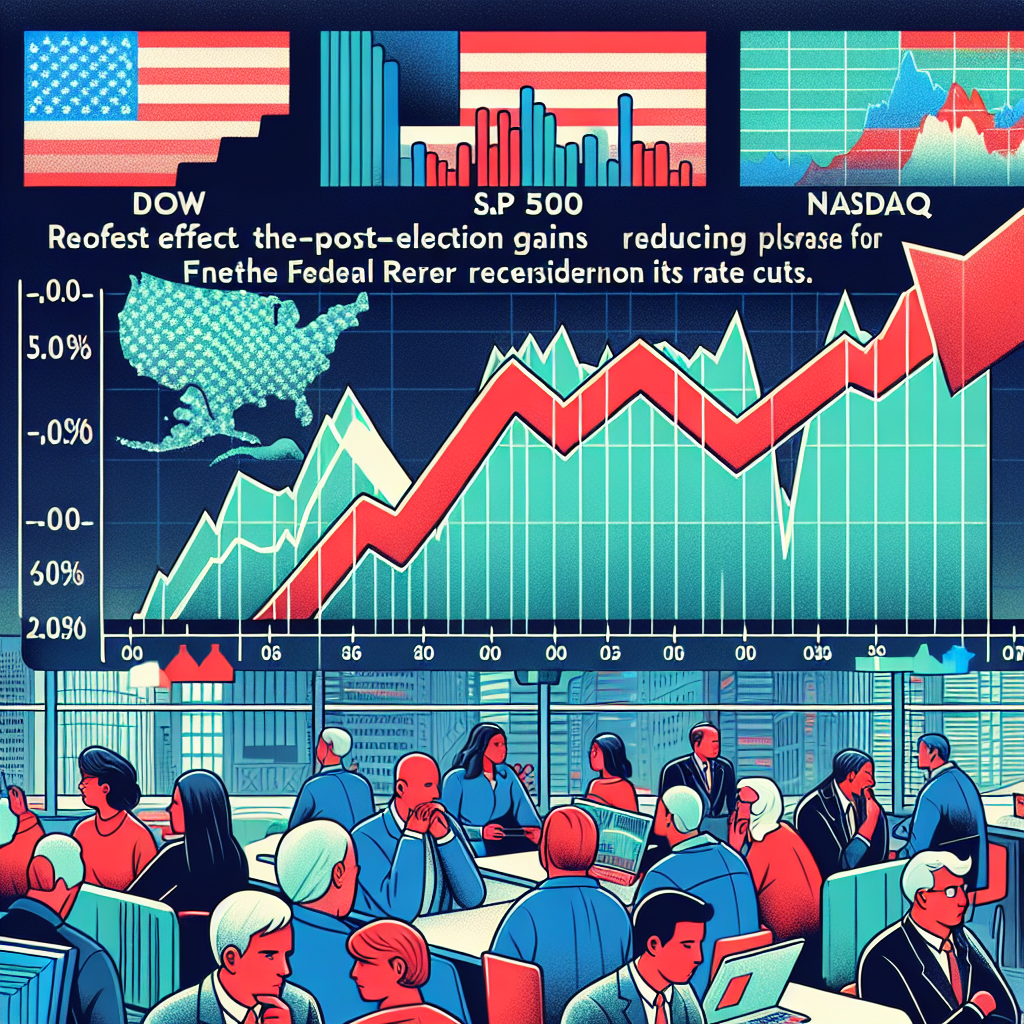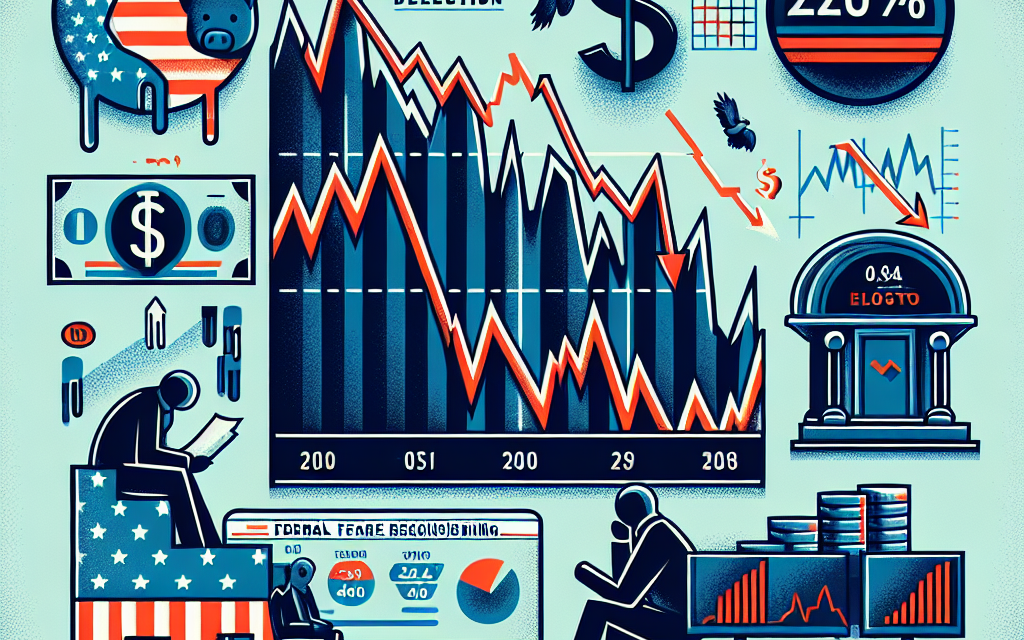“Market Momentum Wanes: Post-Election Gains Fade Amid Fed’s Rate Cut Reassessment”
Introduction
In the wake of the recent elections, the initial optimism that buoyed the stock markets is showing signs of waning, as evidenced by the latest downturn in major indices. The Dow Jones Industrial Average, S&P 500, and Nasdaq Composite have all experienced declines, reflecting investor uncertainty and shifting market dynamics. This pullback comes amid a broader reassessment by the Federal Reserve regarding its monetary policy stance, particularly the potential for future interest rate cuts. As the Fed reevaluates its approach in response to evolving economic indicators, market participants are recalibrating their expectations, leading to increased volatility and a recalibration of post-election gains.
Impact Of Post-Election Market Trends On Dow, S&P 500, And Nasdaq
In the wake of the recent elections, the financial markets have experienced a notable shift, with the Dow Jones Industrial Average, the S&P 500, and the Nasdaq Composite all witnessing declines. This downturn comes as the initial post-election gains begin to wane, prompting investors to reassess their strategies amidst a changing economic landscape. The initial optimism that followed the election results was driven by expectations of policy stability and potential economic stimulus. However, as the dust settles, market participants are now grappling with the reality of a complex economic environment, characterized by persistent inflationary pressures and geopolitical uncertainties.
The Dow, S&P 500, and Nasdaq, which had initially surged on the back of investor optimism, are now facing headwinds as the Federal Reserve reevaluates its monetary policy stance. The central bank’s decision to reconsider the pace and timing of interest rate cuts has introduced a new layer of uncertainty into the markets. Previously, the anticipation of rate cuts had buoyed investor sentiment, as lower borrowing costs typically stimulate economic activity and corporate profitability. However, with the Fed signaling a more cautious approach, concerns about the sustainability of economic growth have resurfaced.
Moreover, the impact of inflation cannot be understated. Rising prices have eroded consumer purchasing power and increased input costs for businesses, thereby squeezing profit margins. This has led to a recalibration of earnings expectations, which in turn has weighed on stock valuations. The technology sector, which is heavily represented in the Nasdaq, has been particularly vulnerable to these dynamics. High-growth tech companies, which often rely on future earnings potential, are more sensitive to changes in interest rates and inflation expectations. Consequently, the Nasdaq has experienced more pronounced volatility compared to its counterparts.
In addition to domestic factors, global economic conditions have also played a role in shaping market trends. Supply chain disruptions, exacerbated by geopolitical tensions, have further complicated the economic outlook. These disruptions have not only contributed to inflationary pressures but have also hindered the ability of companies to meet demand, thereby impacting revenue growth. As a result, investors are increasingly cautious, seeking refuge in more defensive sectors and asset classes.
Despite these challenges, it is important to recognize that market fluctuations are a natural part of the economic cycle. While the current environment presents obstacles, it also offers opportunities for discerning investors. Companies with strong fundamentals and the ability to adapt to changing conditions are likely to emerge stronger in the long run. Furthermore, sectors that benefit from structural trends, such as renewable energy and digital transformation, continue to attract interest.
In conclusion, the recent declines in the Dow, S&P 500, and Nasdaq reflect a confluence of factors, including the reevaluation of monetary policy by the Federal Reserve, persistent inflationary pressures, and global economic uncertainties. As investors navigate this complex landscape, a focus on fundamentals and long-term trends will be crucial. While the path forward may be fraught with challenges, it also holds the potential for growth and innovation. As such, maintaining a balanced perspective and a diversified portfolio will be key to weathering the current market dynamics and capitalizing on future opportunities.
Federal Reserve’s Reassessment Of Rate Cuts: Implications For Investors
In recent weeks, the financial markets have experienced a notable shift as the initial post-election gains have begun to wane, with the Dow Jones Industrial Average, S&P 500, and Nasdaq Composite all experiencing declines. This downturn can be attributed, in part, to the Federal Reserve’s reassessment of its monetary policy, particularly concerning potential rate cuts. As investors navigate this evolving landscape, understanding the implications of the Fed’s actions becomes crucial.
The Federal Reserve, which plays a pivotal role in shaping economic conditions through its monetary policy decisions, has recently signaled a more cautious approach to interest rate adjustments. Initially, there was widespread anticipation that the Fed would continue to lower interest rates to stimulate economic growth. However, recent statements from key Fed officials suggest a reevaluation of this strategy, driven by a complex interplay of economic indicators and global uncertainties.
One of the primary factors influencing the Fed’s reassessment is the current state of the U.S. economy. While certain sectors have shown resilience, others remain vulnerable, creating a mixed economic picture. Inflation, a critical metric for the Fed, has been relatively subdued, yet there are emerging signs of upward pressure. Additionally, the labor market, although robust, faces challenges such as wage stagnation and uneven job growth across industries. These dynamics compel the Fed to tread carefully, balancing the need to support economic expansion with the risk of overheating.
Moreover, global economic conditions add another layer of complexity to the Fed’s decision-making process. Trade tensions, geopolitical uncertainties, and varying growth rates among major economies contribute to an unpredictable global landscape. The interconnectedness of global markets means that external shocks can quickly reverberate through the U.S. economy, influencing the Fed’s policy considerations. As such, the Fed’s cautious stance reflects a desire to maintain flexibility in responding to both domestic and international developments.
For investors, the Fed’s reassessment of rate cuts carries significant implications. Interest rates are a fundamental driver of financial markets, influencing everything from stock valuations to bond yields. A shift in the Fed’s policy trajectory can alter investor expectations and strategies. For instance, the prospect of fewer rate cuts may lead to increased volatility in equity markets, as investors recalibrate their portfolios in response to changing economic conditions. Additionally, sectors that are sensitive to interest rates, such as real estate and utilities, may experience heightened scrutiny as investors assess their potential for growth in a less accommodative monetary environment.
Furthermore, the Fed’s cautious approach underscores the importance of diversification in investment portfolios. In times of uncertainty, spreading investments across a range of asset classes can help mitigate risk and enhance resilience. Investors may also consider focusing on companies with strong fundamentals and sustainable business models, as these are more likely to weather economic fluctuations.
In conclusion, the Federal Reserve’s reassessment of rate cuts represents a pivotal moment for investors, as it signals a shift in the economic landscape that could have far-reaching effects on financial markets. By closely monitoring the Fed’s actions and remaining adaptable in their investment strategies, investors can better navigate the challenges and opportunities that lie ahead. As the situation continues to evolve, staying informed and proactive will be key to achieving long-term financial success in an ever-changing economic environment.
Analyzing The Decline In Major U.S. Stock Indices
In recent weeks, the major U.S. stock indices, including the Dow Jones Industrial Average, the S&P 500, and the Nasdaq Composite, have experienced a notable decline, erasing much of the gains achieved in the immediate aftermath of the recent elections. This downturn has prompted investors and analysts alike to reassess the factors contributing to this shift in market sentiment. As the Federal Reserve reevaluates its stance on interest rate cuts, the interplay between economic indicators and monetary policy has become a focal point for understanding the current market dynamics.
Initially, the post-election period was marked by a surge in investor optimism, driven by expectations of policy stability and potential economic stimulus measures. However, as the dust settled, market participants began to scrutinize the underlying economic fundamentals more closely. The realization that the anticipated policy changes might not materialize as swiftly or as robustly as hoped has led to a recalibration of market expectations. Consequently, the initial euphoria has given way to a more cautious outlook, contributing to the recent declines in the major indices.
Moreover, the Federal Reserve’s recent signals regarding its approach to interest rates have added another layer of complexity to the market landscape. Previously, the Fed had indicated a willingness to consider further rate cuts to support economic growth. However, recent statements suggest a more measured approach, with officials emphasizing the need to balance growth objectives with concerns about inflationary pressures. This shift in tone has led to increased uncertainty among investors, who are now grappling with the implications of a potentially less accommodative monetary policy environment.
In addition to these domestic factors, global economic conditions continue to exert influence on U.S. markets. Ongoing trade tensions, particularly between the United States and China, have created an atmosphere of uncertainty that weighs heavily on investor sentiment. The lack of a clear resolution to these disputes has led to concerns about the potential impact on global supply chains and economic growth. As a result, market participants remain wary of the broader geopolitical landscape and its potential to disrupt economic stability.
Furthermore, corporate earnings reports have provided mixed signals, adding to the complexity of the current market environment. While some sectors have demonstrated resilience, others have faced headwinds, reflecting the uneven nature of the economic recovery. This divergence in performance has prompted investors to adopt a more selective approach, focusing on companies with strong fundamentals and growth prospects. However, the overall uncertainty has led to increased volatility, as market participants react to the latest earnings announcements and economic data releases.
In light of these developments, it is clear that the recent declines in the Dow, S&P 500, and Nasdaq are the result of a confluence of factors, both domestic and international. As investors navigate this challenging landscape, the importance of staying informed and adaptable cannot be overstated. The interplay between economic indicators, monetary policy, and geopolitical developments will continue to shape market dynamics in the coming months. Consequently, market participants must remain vigilant, ready to adjust their strategies in response to evolving conditions. As the Federal Reserve continues to assess its policy options and global uncertainties persist, the path forward for U.S. stock indices remains uncertain, underscoring the need for a cautious and informed approach to investing.
Historical Context: Market Reactions To Election Outcomes

The financial markets have long been sensitive to political events, with election outcomes often serving as significant catalysts for market movements. Historically, the aftermath of elections has seen varied reactions from investors, influenced by the anticipated economic policies of the incoming administration. In the current scenario, the Dow, S&P 500, and Nasdaq have experienced declines, reflecting a diminishing of the initial post-election gains. This trend is not unprecedented, as markets frequently undergo a period of adjustment following the initial euphoria or apprehension that accompanies election results.
To understand the current market dynamics, it is essential to consider the historical context of how markets have reacted to past election outcomes. Typically, markets respond positively to clear and decisive election results, as they reduce uncertainty and provide a clearer picture of future policy directions. For instance, when an election results in a government perceived as business-friendly, markets often rally in anticipation of favorable economic policies. Conversely, if the election outcome is unexpected or leads to a divided government, markets may react with volatility as investors reassess their strategies in light of potential policy gridlocks.
In the present case, the initial post-election gains were driven by investor optimism regarding potential policy changes and economic stimulus measures. However, as the dust settles, the focus has shifted to the Federal Reserve’s monetary policy stance, particularly concerning interest rate cuts. The Fed’s reevaluation of rate cuts has introduced a new layer of complexity to the market landscape. Historically, the Fed’s monetary policy decisions have played a crucial role in shaping market sentiment. Lower interest rates generally encourage borrowing and investment, providing a boost to economic activity and, by extension, the stock market. Conversely, the prospect of rate hikes or a reevaluation of rate cuts can lead to market apprehension, as higher borrowing costs may dampen economic growth.
The current market decline can be attributed, in part, to the Fed’s cautious approach in reassessing its monetary policy. Investors are now grappling with the implications of a potentially less accommodative monetary environment. This shift in focus from election-driven optimism to monetary policy considerations underscores the intricate interplay between political events and economic fundamentals in shaping market trajectories.
Moreover, the global economic landscape adds another layer of complexity to the market’s response. Trade tensions, geopolitical uncertainties, and varying economic growth rates across regions contribute to the market’s cautious stance. Investors are increasingly aware that while domestic political events are significant, they do not operate in isolation from global economic trends. As such, the market’s reaction to the post-election environment is also influenced by these broader economic factors.
In conclusion, the decline in the Dow, S&P 500, and Nasdaq following the initial post-election gains is a reflection of the market’s adjustment to a more nuanced economic reality. The historical context of market reactions to election outcomes provides valuable insights into the current dynamics, highlighting the importance of both political clarity and economic fundamentals. As the Federal Reserve continues to reevaluate its monetary policy, investors will remain vigilant, balancing optimism with caution in navigating the evolving market landscape. This delicate balance underscores the complexity of market reactions, where political events and economic policies intertwine to shape investor sentiment and market performance.
Investor Strategies Amidst Market Volatility And Fed Decisions
In the wake of recent market fluctuations, investors are grappling with the implications of declining indices and the Federal Reserve’s evolving stance on interest rate cuts. The Dow Jones Industrial Average, S&P 500, and Nasdaq Composite have all experienced notable declines, eroding the gains made in the immediate aftermath of the recent elections. This downturn has prompted investors to reassess their strategies amidst a backdrop of uncertainty and shifting economic policies.
The initial post-election rally was fueled by optimism surrounding potential policy changes and economic stimulus measures. However, as the dust settles, market participants are now contending with a more complex landscape. The Federal Reserve’s reconsideration of its interest rate policy has added another layer of complexity to the investment environment. Initially, the prospect of rate cuts was seen as a catalyst for economic growth, providing a boost to equities. Yet, as the Fed signals a more cautious approach, investors are left to ponder the implications for their portfolios.
In this context, diversification emerges as a key strategy for navigating market volatility. By spreading investments across various asset classes, sectors, and geographies, investors can mitigate risks associated with concentrated exposures. This approach not only helps in cushioning against market downturns but also positions investors to capitalize on potential opportunities in different segments of the market. For instance, while technology stocks have been under pressure, sectors such as healthcare and consumer staples may offer more stable returns in the current environment.
Moreover, the importance of maintaining a long-term perspective cannot be overstated. Market volatility, while unsettling, is an inherent aspect of investing. Historical data suggests that markets tend to recover over time, rewarding those who remain patient and committed to their investment goals. Therefore, rather than reacting impulsively to short-term market movements, investors are encouraged to focus on their long-term objectives and maintain a disciplined approach.
In addition to diversification and a long-term outlook, staying informed about macroeconomic trends and policy developments is crucial. The Federal Reserve’s decisions on interest rates, for instance, have far-reaching implications for various asset classes. A potential delay in rate cuts could impact bond yields, currency valuations, and equity markets. By keeping abreast of such developments, investors can make more informed decisions and adjust their strategies accordingly.
Furthermore, the role of professional financial advice becomes increasingly valuable in times of uncertainty. Financial advisors can provide insights tailored to individual circumstances, helping investors navigate the complexities of the market. They can assist in rebalancing portfolios, identifying emerging opportunities, and managing risks effectively. Engaging with a trusted advisor can offer a sense of reassurance and clarity amidst the noise of market fluctuations.
In conclusion, as the Dow, S&P 500, and Nasdaq face declines and the Federal Reserve reevaluates its rate cut strategy, investors are urged to adopt a multifaceted approach. By diversifying their portfolios, maintaining a long-term perspective, staying informed, and seeking professional guidance, they can better navigate the challenges and opportunities presented by the current market environment. While uncertainty remains a constant, a well-considered strategy can help investors weather the storm and position themselves for future growth.
The Role Of Economic Indicators In Shaping Market Movements
In the ever-evolving landscape of financial markets, economic indicators play a pivotal role in shaping investor sentiment and guiding market movements. Recently, the Dow, S&P 500, and Nasdaq have experienced declines, eroding the gains made in the aftermath of the recent election. This downturn can be attributed to a confluence of factors, with economic indicators serving as critical signals that influence market participants’ decisions. As the Federal Reserve reevaluates its stance on interest rate cuts, understanding the interplay between these indicators and market dynamics becomes increasingly important.
Economic indicators, such as employment figures, inflation rates, and gross domestic product (GDP) growth, provide valuable insights into the health and trajectory of an economy. These metrics are closely monitored by investors, policymakers, and analysts alike, as they offer a glimpse into future economic conditions. For instance, robust employment data may signal a strengthening economy, potentially leading to increased consumer spending and corporate profits. Conversely, rising inflation rates might prompt concerns about eroding purchasing power and the need for monetary policy adjustments.
In the current market environment, the Federal Reserve’s approach to interest rates is under intense scrutiny. Historically, the Fed has utilized rate cuts as a tool to stimulate economic activity during periods of sluggish growth or economic uncertainty. However, the decision to adjust interest rates is not made in isolation; it is heavily influenced by prevailing economic indicators. As the Fed reassesses its strategy, market participants are keenly observing indicators such as inflation trends and labor market conditions to gauge the likelihood of future rate cuts.
The recent decline in major stock indices, including the Dow, S&P 500, and Nasdaq, underscores the sensitivity of markets to shifts in economic indicators and monetary policy expectations. Following the election, initial optimism drove markets higher, fueled by hopes of favorable policy changes and economic recovery. However, as economic data began to paint a more nuanced picture, investor sentiment shifted, leading to a retracement of those gains. This highlights the intricate relationship between economic indicators and market performance, where positive or negative data releases can trigger significant market reactions.
Moreover, the interconnectedness of global economies means that domestic economic indicators are not the sole drivers of market movements. International developments, such as trade negotiations, geopolitical tensions, and foreign economic data, also exert influence. For example, a slowdown in a major trading partner’s economy can have ripple effects, impacting domestic markets and prompting investors to reassess their strategies. Consequently, market participants must adopt a holistic approach, considering both domestic and international indicators when making investment decisions.
In conclusion, economic indicators serve as vital tools for understanding and anticipating market movements. As the Federal Reserve reevaluates its approach to interest rate cuts, the interplay between these indicators and market dynamics becomes increasingly significant. The recent declines in the Dow, S&P 500, and Nasdaq illustrate the profound impact that shifts in economic data and policy expectations can have on investor sentiment. By closely monitoring these indicators, investors can better navigate the complexities of financial markets and make informed decisions in an ever-changing economic landscape.
Future Outlook: Navigating Uncertainty In The Stock Market
In the wake of the recent post-election rally, the stock market has experienced a notable shift, with the Dow Jones Industrial Average, S&P 500, and Nasdaq Composite all witnessing declines. This downturn comes as investors reassess their positions amid evolving economic conditions and the Federal Reserve’s reconsideration of its monetary policy stance, particularly regarding interest rate cuts. As the market grapples with these changes, understanding the future outlook becomes crucial for investors aiming to navigate the uncertainty that lies ahead.
Initially, the post-election period was marked by optimism, driven by expectations of policy stability and potential economic stimulus. However, as the initial euphoria subsides, market participants are now confronted with a more complex landscape. The Federal Reserve’s recent signals of a possible reevaluation of interest rate cuts have added a layer of uncertainty. Previously, the anticipation of rate cuts had buoyed investor sentiment, as lower borrowing costs typically stimulate economic activity and, by extension, corporate earnings. Yet, with the Fed adopting a more cautious approach, the market’s trajectory appears less predictable.
Moreover, the broader economic environment presents its own set of challenges. Inflationary pressures, which have been a persistent concern, continue to influence market dynamics. Rising prices for goods and services can erode consumer purchasing power and squeeze corporate profit margins, thereby impacting stock valuations. In response, the Federal Reserve’s potential shift in monetary policy aims to strike a delicate balance between curbing inflation and supporting economic growth. This balancing act, however, introduces an element of unpredictability, as investors attempt to gauge the Fed’s next moves.
In addition to domestic factors, global economic conditions also play a pivotal role in shaping the market’s future outlook. Geopolitical tensions, trade negotiations, and supply chain disruptions remain key considerations for investors. These external factors can exacerbate market volatility, as they influence investor sentiment and corporate strategies. For instance, ongoing trade discussions between major economies have the potential to impact global trade flows, thereby affecting the performance of multinational corporations and, consequently, stock indices.
Amidst these uncertainties, investors are increasingly turning to diversification as a strategy to mitigate risk. By spreading investments across various asset classes and sectors, investors aim to cushion their portfolios against potential downturns in specific areas of the market. Additionally, a focus on companies with strong fundamentals and resilient business models is gaining traction. Such companies are perceived as better equipped to weather economic fluctuations and deliver consistent returns over the long term.
Furthermore, technological advancements and innovation continue to shape the investment landscape. Sectors such as technology, healthcare, and renewable energy are garnering attention for their growth potential and ability to drive future economic expansion. As investors seek opportunities in these areas, they must also remain vigilant about the inherent risks associated with rapid technological change and regulatory developments.
In conclusion, the current market environment is characterized by a confluence of factors that contribute to its complexity and uncertainty. As the Dow, S&P 500, and Nasdaq navigate this evolving landscape, investors must remain informed and adaptable. By closely monitoring economic indicators, central bank policies, and global developments, they can make informed decisions that align with their investment objectives. While challenges persist, opportunities for growth and resilience exist for those who approach the market with a strategic and forward-looking mindset.
Q&A
1. **What caused the decline in the Dow, S&P 500, and Nasdaq?**
The decline was caused by diminishing post-election gains and the Federal Reserve reevaluating potential rate cuts.
2. **How did the post-election gains impact the market initially?**
Initially, post-election gains led to a rally in the markets, boosting investor confidence and driving up stock prices.
3. **Why is the Federal Reserve reevaluating rate cuts?**
The Federal Reserve is reevaluating rate cuts due to changing economic conditions and the need to balance inflation control with economic growth.
4. **What sectors were most affected by the market decline?**
Technology, financials, and consumer discretionary sectors were among the most affected by the market decline.
5. **How did investors react to the market decline?**
Investors reacted with caution, leading to increased volatility and a shift towards safer assets like bonds and gold.
6. **What are the potential implications of the Fed’s reevaluation of rate cuts?**
The potential implications include increased market uncertainty, potential changes in borrowing costs, and impacts on consumer spending and business investment.
7. **What strategies might investors consider in response to the current market conditions?**
Investors might consider diversifying their portfolios, focusing on defensive stocks, and monitoring economic indicators closely to adjust their strategies accordingly.
Conclusion
The recent market update indicates a decline in the Dow, S&P 500, and Nasdaq, reflecting a reduction in the post-election gains that had previously buoyed investor sentiment. This downturn is largely attributed to the Federal Reserve’s reassessment of potential rate cuts, which has introduced uncertainty into the market. Investors are now recalibrating their expectations in light of the Fed’s cautious stance, leading to increased volatility. The market’s reaction underscores the sensitivity of equities to monetary policy signals and highlights the ongoing challenges in navigating the economic landscape amid shifting fiscal and monetary dynamics.





